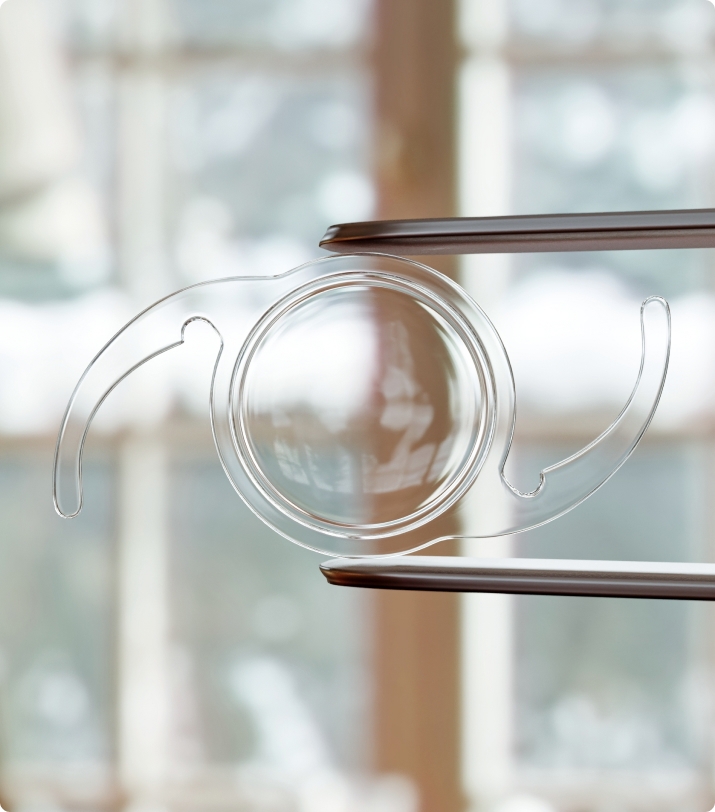Are You Suffering from these Symptoms of Cataracts?

Blurring of vision is the commonest symptom of cataracts which gets worse with time as less light reaches the retina.

Cataracts also affect colour vision; some colours may appear faded and objects may acquire a brownish or yellowish tint.

It can be difficult for a person with cataracts to see in bright sunlight. Indoor lights may begin to seem too bright, or they may appear to have halos around them.

Cataracts may result in patients seeing double images.
Let our cataract surgeon and optometrists run a series of eye tests for you to evaluate the health of your eyes and severity of cataracts.
Let our cataract surgeon and optometrists run a series of eye tests for you to evaluate the health of your eyes and severity of cataracts.
Depending on your results, we will let you know if you have cataracts and what type of cataract surgery is suitable for you. Either way, you will leave us with clear vision!
Why Choose Dr Leo Seo Wei as your Cataract Surgeon?
Over the past two decades, our experienced cataract surgeon Dr Leo Seo Wei has helped many patients suffering from cataracts achieve clear vision. Our eye clinic is one of the few in private practice that is fully equipped with the bladeless femtosecond laser technology. Our cataract surgeon is also well-trained in this new technology to bring better surgical outcomes for patients. For patients who may not be eligible for the bladeless cataract surgery, our clinic also offers the conventional cataract procedure.


What Are The Benefits of Cataract Surgery?
In bladeless cataract surgery, the corneal incision and circular cut can now be done through the femtosecond laser, which mean that they are now perfectly precise and circular, respectively. Not only does the laser make a perfectly centered and circular cut at the front of the lens capsule, it also makes the corneal incisions in pre-programmed cuts with a very specific location, length and depth.
Surprisingly, these complex steps are completed in just less than a minute with an image-guided system that provides clear 3D images of the eye in real time.
The use of laser decreases the amount of ultrasound energy used during phacoemulsification, thereby reducing the risk of injury and complications.
In the femtosecond laser cataract surgery, it eliminates the need for sharp instruments on the eye, as the technique is gentler and more precise for the patient’s eye, leading to better outcomes for those eligible for the bladeless procedure.
When Should I Undergo Cataract Surgery?
Although cataracts are not painful or life-threatening, they do result in worsening vision loss, which can be a significant loss of quality of life for many people.
There are times when patients with cataracts are not asked to immediately undergo cataract surgery. This is because some cataracts do not present any noticeable symptoms yet, and do not affect everyday activities.
However, the moment your cataract hinders your ability to drive safely, especially at night, or makes it difficult to read or see clearly, even with your glasses, you should see a cataract doctor promptly.
Is Cataract Surgery the Only Way?
The only effective and long-lasting way to cure cataracts is through cataract surgery. Doctors can choose between traditional surgical techniques and bladeless laser surgery. Regardless of the technique used, it will do the same thing—remove the natural cloudy lens and replace it with an artificial clear one.
Types of Cataract Surgery Available
Cataract surgery is one of the most commonly performed procedures in Singapore. There are several types of cataract surgeries, including:

Phacoemulsification
The cataract surgeon will make an incision in the cornea with a hand-held blade to create an opening to reach the lens. A circular opening is created through forceps at the top of the cataract lens bag. The cataract is then emulsified with high-frequency ultrasound energy before being suctioned out of the eye through a small tube, and an IOL is inserted.

Extracapsular Cataract Extraction
Extracapsular cataract extradition is commonly used in cases where the cataract is very hard or there are other eye complications. A larger incision is made in the cornea, and the entire lens capsule, containing the cataract, is removed in one piece. While effective, this approach has a longer recovery time and may require additional stitches.

Bladeless Cataract Surgery
Bladeless cataract surgery utilises a more advanced technology to remove cataracts. It uses a femtosecond laser to create a highly precise corneal incision, and sometimes even fragment the cataract before ultrasound is used. The IOL is then inserted and the incision usually does not need stitches. With this method, the laser knows the exact location, size and depth required to make very precise incisions.

There are various types of intraocular lenses (IOLs) to replace one’s natural lens with. The type of lens used will depend on the needs and preferences of the patient.
These provide good focus for one distance, typically distance vision. This means you might still need glasses for near tasks. Monofocal IOLs are a good choice for people who prioritise clear-distance vision and are comfortable using reading glasses when needed.
In the femtosecond laser cataract surgery, it eliminates the need for sharp instruments on the eye, as the technique is gentler and more precise for the patient’s eye, leading to better outcomes for those eligible for the bladeless procedure.
These IOLs offer a wider range of clear vision compared to traditional lenses. They focus on far and intermediate distances without needing glasses as much as multifocal IOLs. While EDOF lenses might still require reading glasses for close-up tasks, they can significantly reduce your overall dependence on them.
These IOLs offer a wider range of clear vision compared to traditional lenses. They focus on far and intermediate distances without needing glasses as much as multifocal IOLs. While EDOF lenses might still require reading glasses for close-up tasks, they can significantly reduce your overall dependence on them.
How Long Does It Take to Recover from Cataract Surgery?
Itching and mild discomfort a few days after surgery are normal; it is important to refrain from rubbing or pushing your eyes during this time. You will be advised to wear an eye patch or protective shield for a few days. Your cataract surgeon will also prescribe eye drops to aid in healing and prevent infection.
While most patients notice improvement within a few days, full recovery takes around 4-8 weeks. As you recover, follow-up appointments are essential to closely monitor your progress.
What Will Affect the Results of Cataract Surgery?






Though the bladeless femtosecond laser cataract surgery is better than conventional cataract surgery in terms of precision and gentleness, the cost is no doubt higher due to it being a newer technology.
However, at our clinic, we ensure that our prices are kept competitive and in line with industry standards. Not only that, our staff will also assist you in your insurance filing with the hospital. To determine your level of coverage, please check with your insurance company first for your policy details. We can then assist with the rest.
On 1st June 2009, Health Minister Khaw Boon Wan announced the changes to the Medisave Scheme in Parliament. This change will now allow patients to draw up to $2,450 from their Medisave account to pay for their Cataract Surgery.
A cataract is a condition where the clear lens of the eye becomes cloudy, and most people get them as they age. This prevents light from entering the eye completely, impairing vision and potentially leading to blindness. Some of the condition’s symptoms include blurry vision, glares or halos, seeing colours that appear to be faded, double vision, and poor night vision.
Cataracts are incredibly common, affecting more than 80% of Singaporeans aged 60 and above. This is why cataract surgery in Singapore is one of the most commonly performed elective procedures in the country.
1. Nuclear Cataracts – These IOLs offer a wider range of clear vision compared to traditional lenses. They focus on far and intermediate distances without needing glasses as much as multifocal IOLs. While EDOF lenses might still require reading glasses for close-up tasks, they can significantly reduce your overall dependence on them.
2. Cortical Cataracts – This is a type of cataract that starts as streaks on the edges of the lens and progresses towards the centre, hence interfering with the light that passes through the centre of the lens. Eye injury, age, and a family history of cataracts are some of the major causes of this condition.
3. Posterior Subcapsular Cataracts – Characterised by the opacity of the rear or back portion of the lens, posterior subcapsular cataracts can develop on their own or with other kinds of cataracts. People who have diabetes or use steroids are more vulnerable to developing this form of cataract.
4. Congenital Cataracts – This is a birth defect whereby the baby’s lens is cloudy, and it can affect either one or both of the baby’s eyes. The primary cause of this condition is the shifting of protein in the eye’s lens due to DNA changes, infection, or chemical imbalance.
5. Secondary Cataracts – This type of cataract is also known as an after-cataract and happens when the posterior capsule of the lens experiences opacification after a cataract surgery.
6. Traumatic Cataracts – When a penetrating injury or ocular trauma damages the lens of the fibres, a traumatic cataract may occur, leading to the clouding of the lens
Some of the leading causes of cataracts are ageing and damage to the tissues of the lens of the eye. Certain medical conditions like diabetes can also increase the risk of developing the condition.
Furthermore, people with other eye conditions or who have had previous eye surgeries are at higher risk of developing cataracts. Smoking, excessive alcohol, using steroid medications, obesity, and prolonged exposure to sunlight are major contributors as well.
- Visual Acuity Test – This is the familiar eye chart test that measures how well you see at various distances.
- Slit Lamp Exam – This test uses a special microscope with a bright light source to examine the different parts of your eye, including the cornea, iris, and lens. This allows for a detailed examination of the lens for any signs of cataract formation, such as cloudiness or opacities.
- Dilated Eye Examination – In this test, eye drops are used to widen (dilate) your pupils, allowing a better view of the back of your eye, including the retina and optic nerve. With the use of a slit lamp and/or an ophthalmoscope, the doctor can detect any signs of cataracts or rule out other causes of vision problems.


